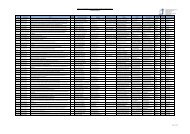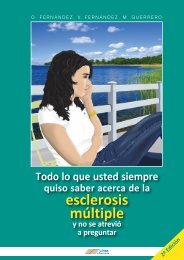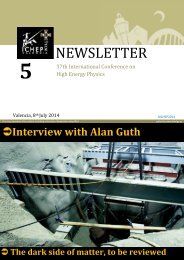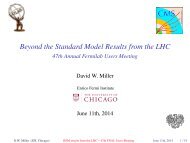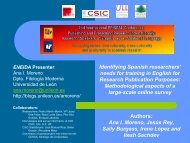PW_mar13_sample_issue
PW_mar13_sample_issue
PW_mar13_sample_issue
Create successful ePaper yourself
Turn your PDF publications into a flip-book with our unique Google optimized e-Paper software.
Linda A Cicero/Stanford News Service A<br />
physicsworld.com<br />
Reviews<br />
Lowry Kirkby<br />
physics primer, with equations<br />
Thirst for physics<br />
Leonard Susskind’s<br />
popular series of<br />
lectures for the<br />
general public have<br />
been compiled in<br />
this book.<br />
The Theoretical<br />
Minimum: What You<br />
Need to Know to<br />
Start Doing Physics<br />
Leonard Susskind<br />
and George<br />
Hrabovsky<br />
2013 Basic Books<br />
£20.00/$26.99hb<br />
256pp<br />
The mantra for popular-science<br />
books is to minimize the use of<br />
equations. In The Theoretical Minimum:<br />
What You Need to Know to<br />
Start Doing Physics, authors Leonard<br />
Susskind and George Hrabovsky<br />
have taken the opposite approach by<br />
producing a physics book for the educated<br />
general public that emphasizes<br />
the mathematics needed to solve<br />
physics problems.<br />
When I first heard about the premise<br />
of the book, I was intrigued. Is<br />
there a group of people who want to<br />
solve physics and mathematics problems,<br />
and not simply read about the<br />
gee-whiz physics that is the standard<br />
fare of most popular-science books?<br />
To my surprise, apparently there is.<br />
The Theoretical Minimum is the product<br />
of a series of lectures that Susskind<br />
presented for the general public<br />
in the Stanford area – all of which<br />
can be found video-recorded on the<br />
Web – and these lectures attracted a<br />
large following of people who were,<br />
in Susskind’s words “hungry to learn<br />
physics”. Indeed, Hrabovsky himself<br />
was one of those people. Now president<br />
of the Madison Area Science<br />
and Technology organization, which<br />
is devoted to research and education,<br />
Hrabovsky has no formal scientific<br />
training but taught himself physics<br />
and mathematics – presumably<br />
through courses and books similar<br />
to The Theoretical Minimum.<br />
This thirst for academic learning<br />
outside of a conventional university<br />
degree reminded me of the<br />
recent and rapid growth of so-called<br />
massive open online courses, or<br />
MOOCs: open-access (i.e. free) university<br />
courses that give people of<br />
any age or background the chance<br />
to learn about a subject that inter-<br />
ests them, at their own pace (see p9).<br />
Like MOOCs, The Theoretical Minimum<br />
allows knowledge-lovers to get<br />
their teeth into the kind of physics<br />
and mathematics problems that one<br />
would normally face during a university<br />
degree. As Susskind puts it,<br />
it is intended for “people who once<br />
wanted to study physics, but life got<br />
in the way”.<br />
The book is written in the form<br />
of 11 short lectures that cover classical<br />
mechanics, plus a final chapter<br />
on electromagnetism. Though<br />
replete with equations, it remains<br />
very readable. Abstract concepts are<br />
well explained, usually in a couple<br />
of different ways to give the reader<br />
a good conceptual overview of the<br />
principle at hand. For example, one<br />
does not need to understand every<br />
detail of a given equation in order<br />
to comprehend its power and its use,<br />
since these are explained in the text.<br />
In addition, each lecture includes<br />
several exercises, allowing readers<br />
to put their problem-solving skills<br />
into practice. (Solutions to the exercises<br />
are posted on the Web.) The<br />
first three chapters include mathematical<br />
interludes on trigonometry,<br />
vector notation, differentiation and<br />
integration. These discussions are<br />
complete, and would serve as a good<br />
reminder for someone who is already<br />
familiar with calculus; however, they<br />
are also rather terse, and would likely<br />
be too advanced for someone who<br />
wishes to learn it for the first time.<br />
Is this really just the minimum<br />
you need to know to start doing<br />
physics? To me, the answer is an<br />
emphatic “no”: this book covers far<br />
more than the minimum. The first<br />
five chapters cover the core classical<br />
mechanics principles of motion and<br />
dynamics, including conservation of<br />
energy and momentum, while the<br />
material covered in the second half<br />
of the book (chapters 6–12) is usually<br />
considered “advanced classical<br />
mechanics”. This material – which<br />
includes Lagrangian and Hamiltonian<br />
mechanics and their applications<br />
to electric and magnetic forces<br />
– is often not taught at undergradu-<br />
Physics World March 2013 59



